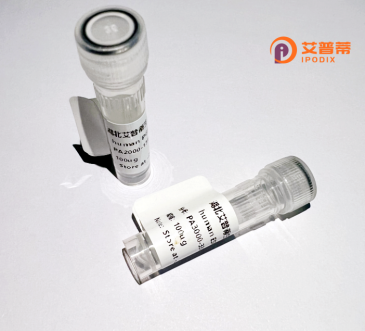
| 纯度 | >90%SDS-PAGE. |
| 种属 | Human |
| 靶点 | ZEB1 |
| Uniprot No | P37275 |
| 内毒素 | < 0.01EU/μg |
| 表达宿主 | E.coli |
| 表达区间 | 1-900 aa |
| 活性数据 | NIAIPTVTAQLPTIVAIADQNSVPCLRALAANKQTILIPQVAYTYSTTVSPAVQEPPLKVIQPNGNQDERQDTSSEGVSNVEDQNDSDSTPPKKKMRKTE |
| 分子量 | 36.74 kDa |
| 蛋白标签 | GST-tag at N-terminal |
| 缓冲液 | PBS, pH7.4, containing 0.01% SKL, 1mM DTT, 5% Trehalose and Proclin300. |
| 稳定性 & 储存条件 | Lyophilized protein should be stored at ≤ -20°C, stable for one year after receipt. Reconstituted protein solution can be stored at 2-8°C for 2-7 days. Aliquots of reconstituted samples are stable at ≤ -20°C for 3 months. |
| 复溶 | Always centrifuge tubes before opening.Do not mix by vortex or pipetting. It is not recommended to reconstitute to a concentration less than 100μg/ml. Dissolve the lyophilized protein in distilled water. Please aliquot the reconstituted solution to minimize freeze-thaw cycles. |
1. **"ZEB1 promotes metastasis in a mouse model of invasive lobular carcinoma"**
- **作者**: Spaderna et al.
- **摘要**: 研究揭示了ZEB1通过驱动上皮-间充质转化(EMT)促进乳腺癌细胞侵袭和转移的机制,强调其在癌症转移中的关键作用。
2. **"A reciprocal repression between ZEB1 and members of the miR-200 family promotes EMT and invasion in cancer cells"**
- **作者**: Burk et al.
- **摘要**: 阐明了ZEB1与miR-200家族的双向抑制调控网络,说明该互作如何增强癌细胞EMT表型及迁移能力。
3. **"ZEB1 protein interacts with SMADs to reinforce TGF-β-induced EMT"**
- **作者**: Postigo et al.
- **摘要**: 报道ZEB1直接结合SMAD蛋白,协同增强TGF-β信号通路诱导的EMT,揭示了其在转录水平调控肿瘤进展的分子机制。
4. **"ZEB1 mediates drug resistance through activation of STAT3 in colorectal cancer"**
- **作者**: Shao et al.
- **摘要**: 发现ZEB1通过激活STAT3通路增强结直肠癌细胞对化疗药物的耐药性,提示其作为治疗靶点的潜力。
---
*注:以上文献主要围绕ZEB1的功能研究,涉及重组蛋白的应用实验可能隐含在方法学中。如需具体重组蛋白构建/纯化研究,建议补充筛选方向。*
ZEB1 (Zinc Finger E-Box Binding Homeobox 1) is a transcription factor belonging to the zinc finger homeodomain family, characterized by its conserved C-terminal zinc finger clusters and N-terminal DNA-binding homeodomain. It plays a pivotal role in epithelial-to-mesenchymal transition (EMT), a critical process in embryonic development, wound healing, and cancer metastasis. ZEB1 represses epithelial markers (e.g., E-cadherin) by binding to E-box motifs in gene promoters, while promoting mesenchymal traits, thereby regulating cell plasticity and invasiveness. Dysregulation of ZEB1 is implicated in tumor progression, chemoresistance, and poor prognosis in various cancers, including breast, lung, and colorectal carcinomas.
Recombinant human ZEB1 protein is typically produced using heterologous expression systems (e.g., E. coli or mammalian cells) to enable functional studies. Purified ZEB1 retains DNA-binding activity and is utilized in electrophoretic mobility shift assays (EMSAs), chromatin immunoprecipitation (ChIP), and in vitro transcriptional assays to dissect its regulatory mechanisms. Researchers also employ recombinant ZEB1 to explore interactions with co-repressors (e.g., CtBP, HDACs) or signaling pathways (e.g., TGF-β, Wnt). Its role in EMT has made it a target for therapeutic strategies aiming to inhibit metastasis. However, challenges remain in understanding context-dependent functions, post-translational modifications, and tissue-specific regulatory networks involving ZEB1.
×